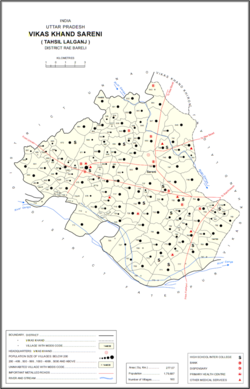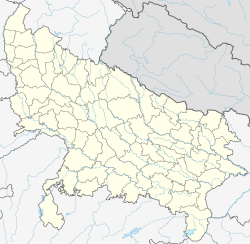world.wikisort.org - India
Gajpati Khera is a village in Sareni block of Rae Bareli district, Uttar Pradesh, India.[2] It is located 21 km from Lalganj, the tehsil headquarters.[3] As of 2011, it has a population of 1,273 people, in 216 households.[2] It has two primary schools and no healthcare facilities.[2] It belongs to the nyaya panchayat of Bhojpur.[4]
Gajpati Khera | |
|---|---|
Village | |
 Map showing Gajpati Khera (#665) in Sareni CD block | |
 Gajpati Khera Location in Uttar Pradesh, India | |
| Coordinates: 26.178768°N 80.764718°E[1] | |
| Country | |
| State | Uttar Pradesh |
| District | Raebareli |
| Area | |
| • Total | 0.824 km2 (0.318 sq mi) |
| Population (2011)[2] | |
| • Total | 1,273 |
| • Density | 1,500/km2 (4,000/sq mi) |
| Languages | |
| • Official | Hindi |
| Time zone | UTC+5:30 (IST) |
| Vehicle registration | UP-35 |
The 1951 census recorded Gajpati Khera (as "Ghazi Patti Khera") as comprising 2hamlets, with a total population of 406 people (205 male and 201 female), in 70 households and 68 physical houses.[5] The area of the village was given as 199 acres.[5] 27 residents were literate, 19 male and 8 female.[5] The village was listed as belonging to the pargana of Sareni and the thana of Sareni.[5]
The 1961 census recorded Gajpati Khera as comprising 2 hamlets, with a total population of 543 people (280 male and 263 female), in 74 households and 53 physical houses.[6] The area of the village was given as 199 acres.[6]
The 1981 census recorded Gajpati Khera as having a population of 841 people, in 133 households, and having an area of 80.53 hectares.[3] The main staple foods were given as wheat and rice.[3]
The 1991 census recorded Gajpati Khera as having a total population of 996 people (513 male and 483 female), in 154 households and 154 physical houses.[4] The area of the village was listed as 83 hectares.[4] Members of the 0-6 age group numbered 229, or 23% of the total; this group was 50% male (115) and 50% female (114).[4] Members of scheduled castes made up 3% of the village's population, while no members of scheduled tribes were recorded.[4] The literacy rate of the village was 37% (263 men and 104 women).[4] 223 people were classified as main workers (218 men and 5 women), while 0 people were classified as marginal workers; the remaining 547 residents were non-workers.[4] The breakdown of main workers by employment category was as follows: 153 cultivators (i.e. people who owned or leased their own land); 36 agricultural labourers (i.e. people who worked someone else's land in return for payment); 0 workers in livestock, forestry, fishing, hunting, plantations, orchards, etc.; 0 in mining and quarrying; 5 household industry workers; 8 workers employed in other manufacturing, processing, service, and repair roles; 2 construction workers; 7 employed in trade and commerce; 2 employed in transport, storage, and communications; and 10 in other services.[4]
References
- "Geonames Search". Search for "Gajpati Khera" here.
- "Census of India 2011: Uttar Pradesh District Census Handbook - Rae Bareli, Part A (Village and Town Directory)" (PDF). Census 2011 India. pp. 262–87. Retrieved 14 August 2021.
- Census 1981 Uttar Pradesh: District Census Handbook Part XIII-A: Village & Town Directory, District Rae Bareli (PDF). 1982. pp. 138–9. Retrieved 14 August 2021.
- Census 1991 Series-25 Uttar Pradesh Part-XII B Village & Townwise Primary Census Abstract District Census Handbook District Raebareli (PDF). 1992. pp. xxiv–xxviii, 164–5. Retrieved 22 October 2021.
- Census of India, 1951: District Census Handbook Uttar Pradesh (42 - Rae Bareli District) (PDF). Allahabad. 1955. pp. 108–9. Retrieved 22 October 2021.
- Census 1961: District Census Handbook, Uttar Pradesh (39 - Raebareli District) (PDF). Lucknow. 1965. pp. lxviii-lxix of section "Dalmau Tahsil". Retrieved 14 August 2021.
Другой контент может иметь иную лицензию. Перед использованием материалов сайта WikiSort.org внимательно изучите правила лицензирования конкретных элементов наполнения сайта.
WikiSort.org - проект по пересортировке и дополнению контента Википедии